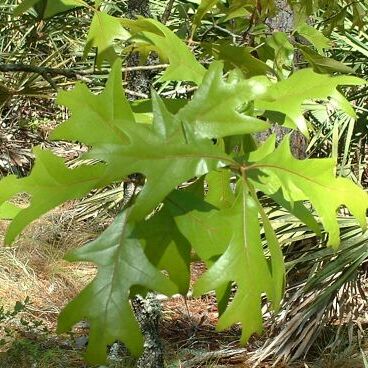Trees or shrubs , deciduous, to 20 m. Bark bluish gray, deeply furrowed, inner bark orangish or reddish. Twigs dark reddish brown with distinct grayish cast, (1.5-)2-3.5(-4) mm diam., sparsely pubescent to almost glabrous. Terminal buds light brown to reddish brown, conic or narrowly ovoid-ellipsoid, 5.5-12 mm, pubescent. Leaves: petiole 5-25 mm, glabrous. Leaf blade circular or broadly ovate-elliptic, widest near or proximal to middle, 100-200 × 80-150 mm, base attenuate to acute, occasionally obtuse or rounded, blade decurrent on petiole, margins with 3-7(-9) lobes and 7-20 awns, lobes attenuate to falcate, occasionally oblong or distally expanded, apex acute to acuminate; surfaces abaxially occasionally orange-scurfy, usually glabrous except for conspicuous axillary tufts of tomentum, adaxially glabrous, secondary veins raised on both surfaces. Acorns biennial; cup somewhat goblet-shaped, 9-14 mm high × 16-24 mm wide, covering 1/3 nut, outer surface puberulent, inner surface pubescent, scales occasionally tuberculate, tips loose, especially at margin of cup, acute, margin conspicuously involute; nut ovoid to broadly ellipsoid, 17-28 × 12-18 mm, often faintly striate, glabrate, scar diam. 6-10 mm.
More
A small tree. It grows 6-12 m high. The trunk is 30 cm across. They bark is grey to black and becomes thick and very rough. It becomes furrowed into ridges. It has an irregular open crown. The branches are crooked. The leaves are 10-20 cm long and 7.5-15 cm wide. They are almost triangle shaped. They have a pointed base and 3-5 long narrow lobes. These have 1-3 bristle tipped teeth at the end. The leaves are thick and stiff. They are shiny yellow-green above and paler underneath. There are tufts of rust coloured hairs in the angles of the veins. The leaves turn red in autumn. The acorns are 2-2.5 cm long and egg-shaped. They are in hairy cups.
Tree to 20 m; lvs obovate, on petioles 0.5–1.5 cm, pubescent in the vein-axils beneath, otherwise glabrous, usually cuneate at base, deeply lobed, the lateral lobes elongate, oblong or slightly broadened distally, with 2–3 bristle-tipped teeth at the tip; acorn 2–2.5 cm, the cup turbinate or deeply saucer-shaped, 2–2.5 cm wide, covering half or a third of the nut, the marginal scales abruptly inflexed. Dry, especially sandy soil, chiefly on the coastal plain; se. Va. to Fla. and La. (Q. catesbaei)
Dry barren sandy ridges, sandy bluffs and hammocks, growing well in almost sterile soil. It often forms pure stands on dry, sandy soils of upland ridges, pinelands and dunes.
More
It is a temperate plant. It grows on dry sandy ridges and dunes. It is usually near the coast. It SE of the USA it grows up to 150 m altitude.


